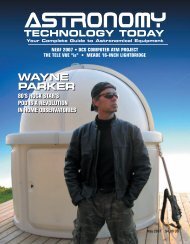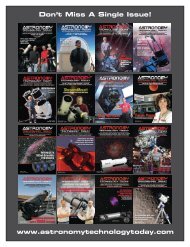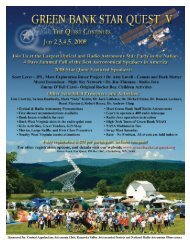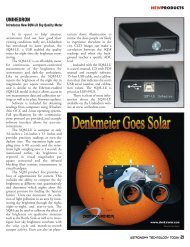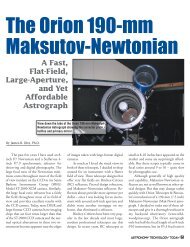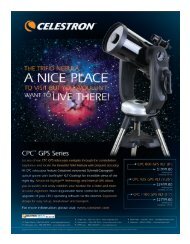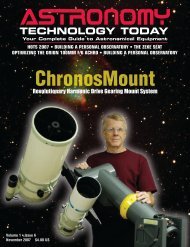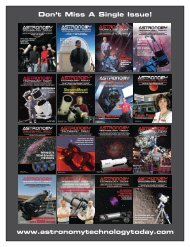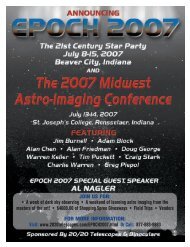iOPTRON - Astronomy Technology Today
iOPTRON - Astronomy Technology Today
iOPTRON - Astronomy Technology Today
Create successful ePaper yourself
Turn your PDF publications into a flip-book with our unique Google optimized e-Paper software.
M-UNO: A PIER-LESS MOUNT<br />
an impressive program, but that’s another<br />
story. I selected the LX200 Classic interface<br />
and, violà, the phone and the mount were<br />
talking to each other.<br />
Even though the skies were obstructed<br />
by clouds, I decided to play around. I guestimated<br />
Sirius' location, slewed the mount<br />
to that point, synced it, and picked objects<br />
seemingly at random to "find." The M-<br />
Uno responded precisely to eachcommand.<br />
It would be entirely possible to<br />
control the M-Uno solely from the smartphone,<br />
but some star parties restrict the use<br />
of wireless devices. Configuring the laptop<br />
to run the M-Uno is necessary if attending<br />
such an event. I also discovered that the<br />
DEC motor setting needed to be reversed<br />
in order for the mount to slew correctly to<br />
the chosen Object.<br />
Unfortunately, Ohio's winter-wonderland<br />
weather prevented futher meaningful<br />
analysis of the M-Uno's capability by the<br />
time this article went to press. Perhaps ATT<br />
will permit me to update these observations<br />
in a subsequent issue.<br />
Looking back on my time till now<br />
with the M-Uno, it’s really difficult to find<br />
any problems withit, but if pressed, I<br />
would have to point to two items, neither<br />
of which reflects poorly on the mount’s design<br />
or manufacture. The M-Uno’s carrying<br />
capacity limits it to smaller-aperture<br />
scopes. That would be the result of achieving<br />
the goal of portability. I have found that<br />
my C-11 represents the upper limit of<br />
portability and, coincidentally, that happens<br />
to be the largest and heaviest telescope<br />
that the M-Uno is rated to carry according<br />
to Luciano. If portability is a priority, the<br />
mobile astrophotographer would likely<br />
avoid larger OTAs anyway. Therefore, the<br />
M-Uno’s payload capacity would not really<br />
be a problem.<br />
The other issue is the length of the<br />
OTA and imaging train the M-Uno can accommodate.<br />
The mount’s shoulder blocks<br />
longer payloads from reaching areas close<br />
to the polar regions when using the standard<br />
saddle. Avalon has a solution for that<br />
problem: An optional extension plate raises<br />
the payload higher from the arm, but doing<br />
that would require placing counterweights<br />
on the underside of the arm to balance<br />
against the leverage of the higher weight<br />
differential.<br />
It is readily apparent that a lot of careful<br />
thought has gone into the M-Uno’s design<br />
and construction. It represents an<br />
enormous advancement in portable<br />
mounts for astrophotography. The Fast Reverse<br />
drive system provides responsive, accurate<br />
tracking motion. The single-arm<br />
design provides a stable platform that enables<br />
the imaging payload to track objects<br />
from horizon to horizon without striking<br />
the mount’s body, pier or tripod. Its stylish<br />
appearance is made to last.<br />
Also, it’s not just for pretty pictures. Luciano<br />
explained that in photometry, a pier<br />
flip results in data being taken through a different<br />
area of the filters. The data is then averaged<br />
to account for possible differences in<br />
the areas of the filters used to collect the<br />
data. With the M-Uno, photometric readings<br />
can be taken uninterrupted through the<br />
same area of the filter, making data averaging<br />
unnecessary. Likewise, when taking<br />
LRGB images, not having to perform a<br />
meridian flip makes registration of all constituent<br />
frames and sub-frames a snap.<br />
This was apparent when I processed<br />
color frames of NGC 891 and M76 taken<br />
at WSP with luminance frames of these objects<br />
I had taken at the Black Forest Star<br />
Party five months before. Had I been able<br />
to image across the meridian, I would have<br />
been able to obtain all LRGB frames at that<br />
event. As it turned out, the color frames I<br />
obtained at WSP required additional processing<br />
time, an effort that M-Uno enabled<br />
me to avoid when I processed the Leo<br />
Triplet image.<br />
Luciano told me that one of his buyers,<br />
a retired amateur withlots of time to<br />
use the mount, brought it in for a check<br />
just for the heck of it. Luciano advised that<br />
after two years of frequent use, the M-Uno<br />
tracked exactly as well as it did when it left<br />
his factory.<br />
The M-Uno is an amazing product<br />
that promises to relieve many of the complications<br />
involved in astro-imaging. From<br />
its ease of transportation and set-up, its<br />
choice of wired or wireless control, its capability<br />
of imaging across the meridian<br />
without a pier flip, zero backlash and<br />
precise tracking of its Fast Reverse drive system,<br />
and its maintenance-free construction,<br />
the M-Uno’s many innovative features<br />
promise to make the mobile astro-imager<br />
more productive and to produce better images.<br />
I was very favorably impressed with<br />
the results it produced. The M-Uno deserves<br />
close attention when choosing an<br />
imaging mount or upgrading a current rig.<br />
Unitronitalia, Avalon’s primary distributor,<br />
has been marketing the M-Uno in<br />
Europe for the past two years. They are<br />
ready to bring it to America. Check it out<br />
at NEAF.<br />
50 <strong>Astronomy</strong> TECHNOLOGY TODAY



